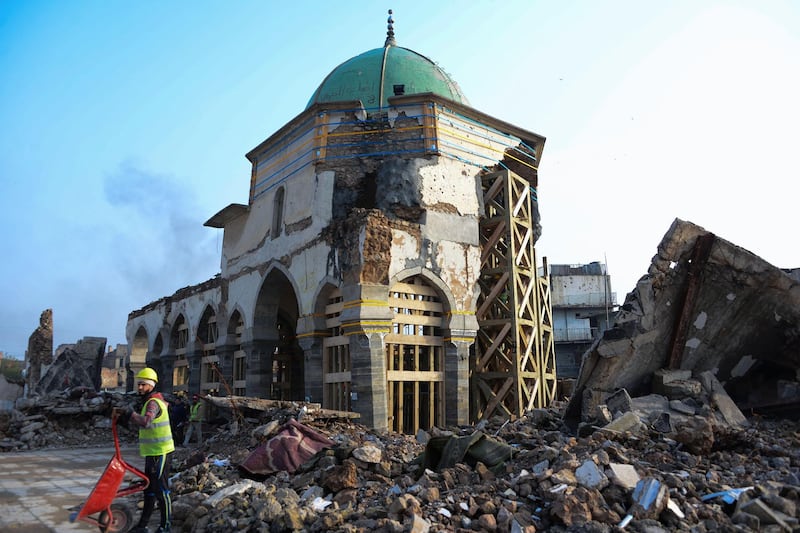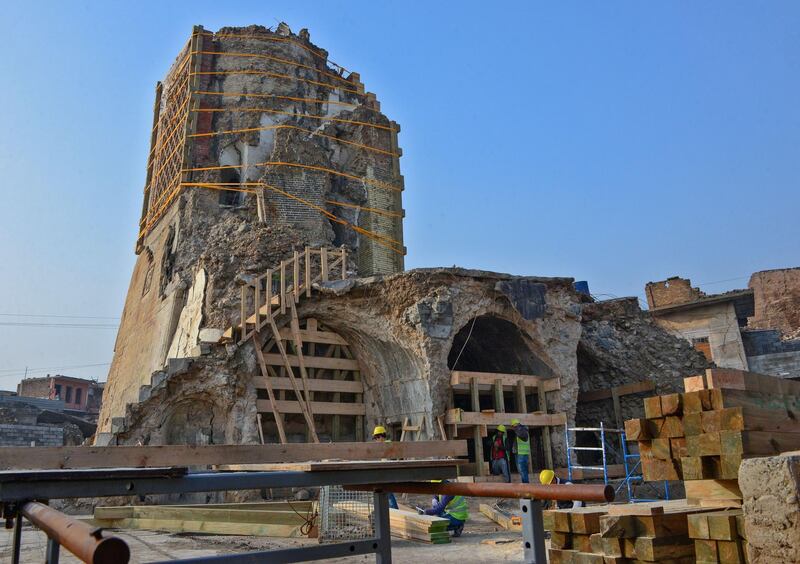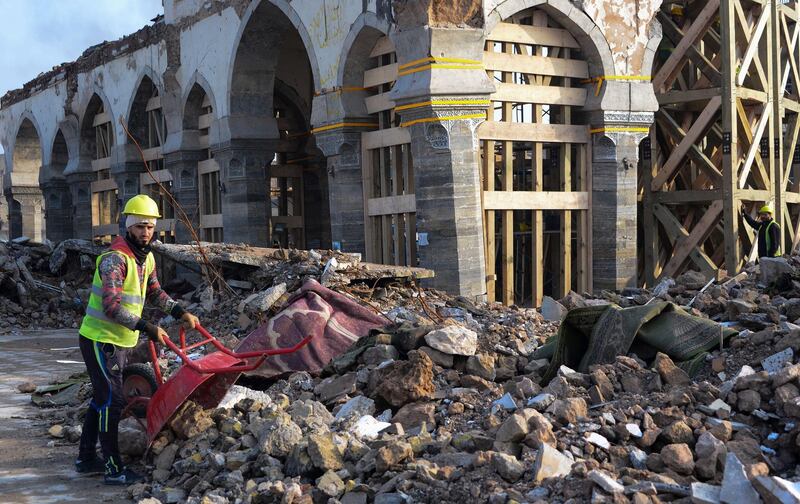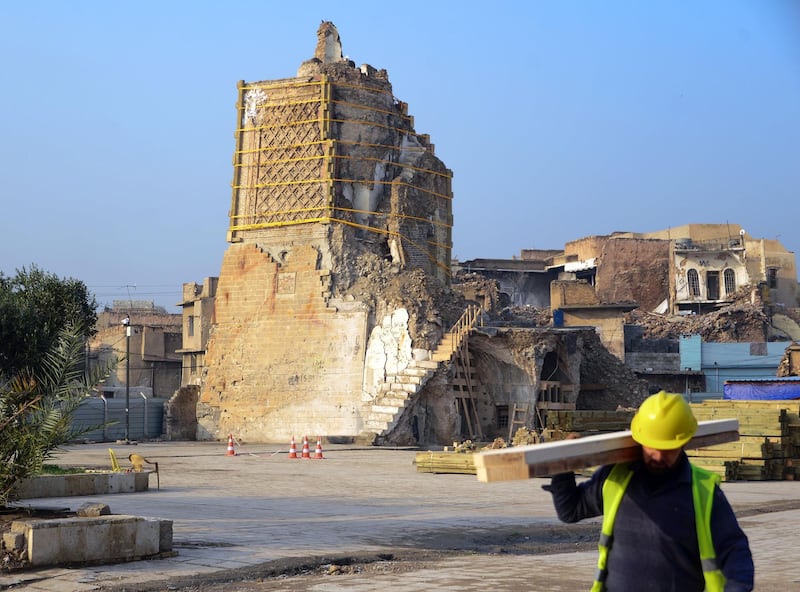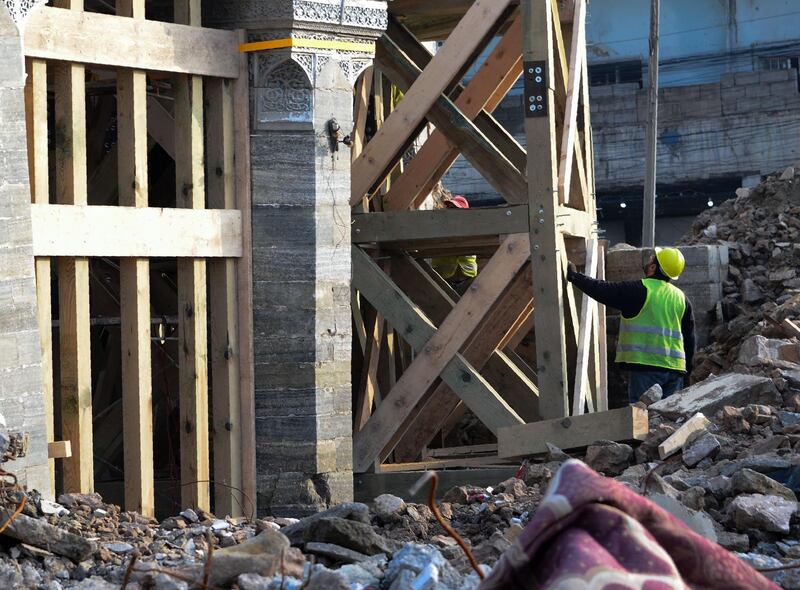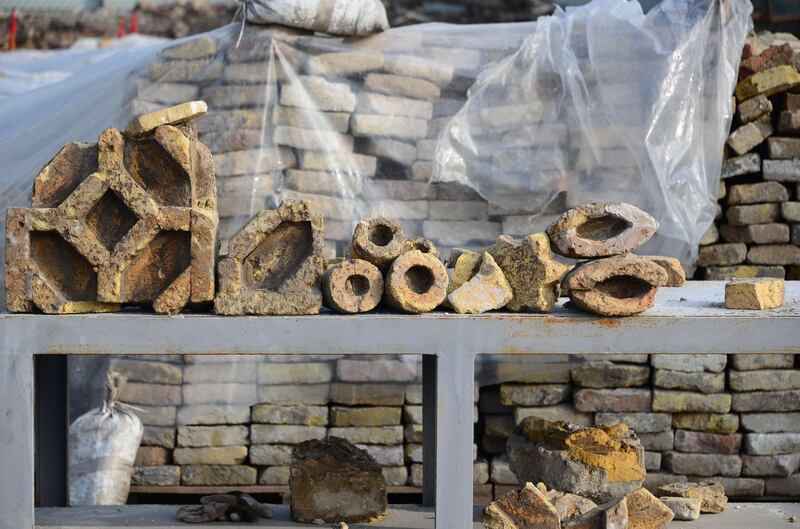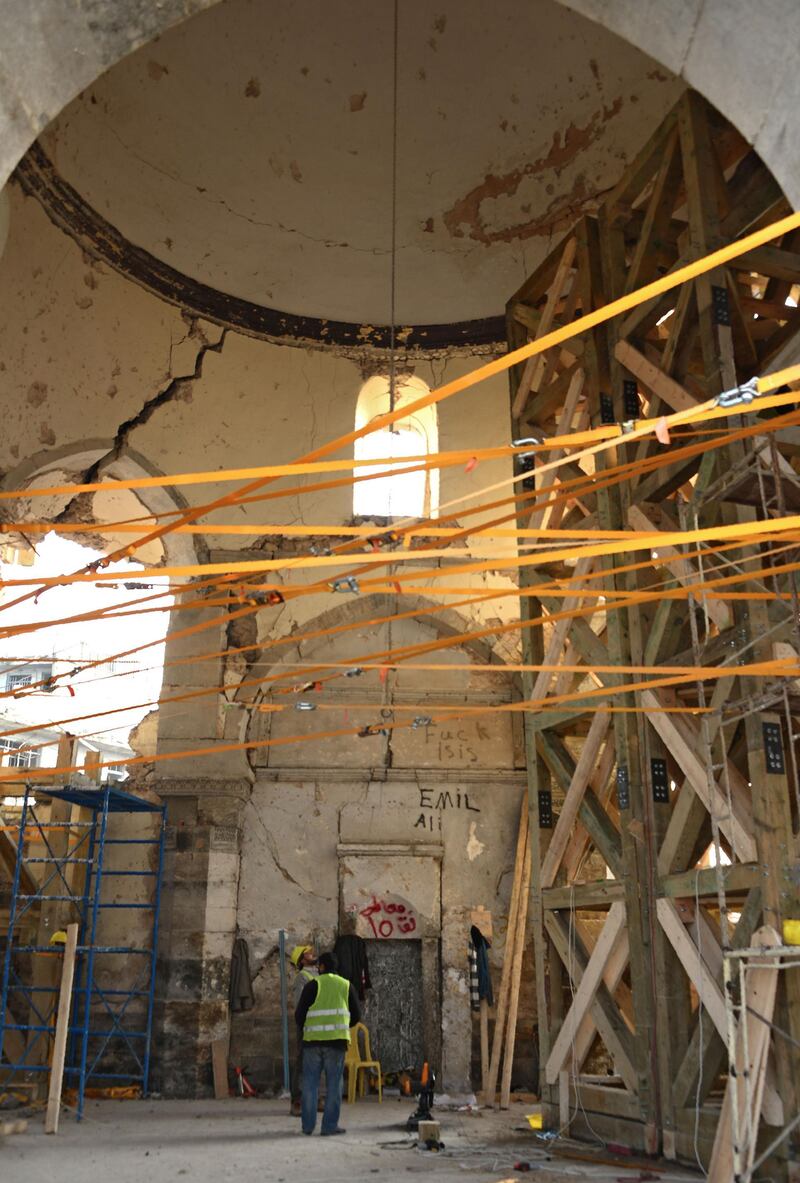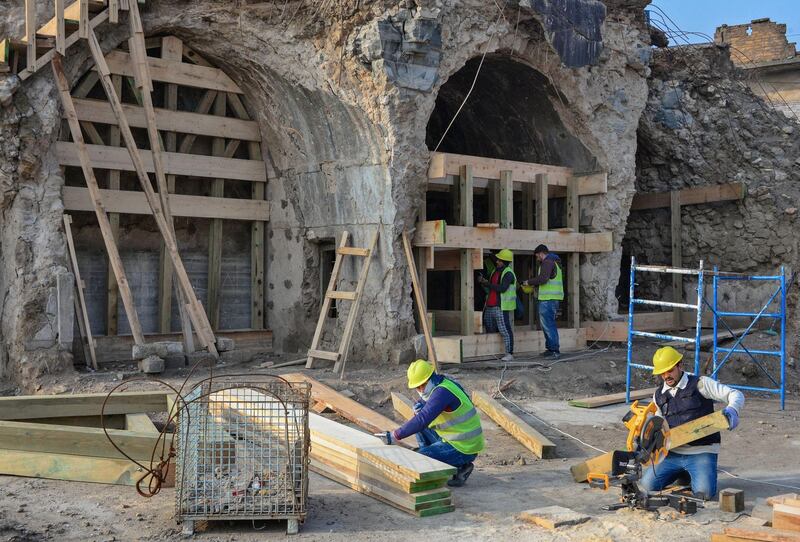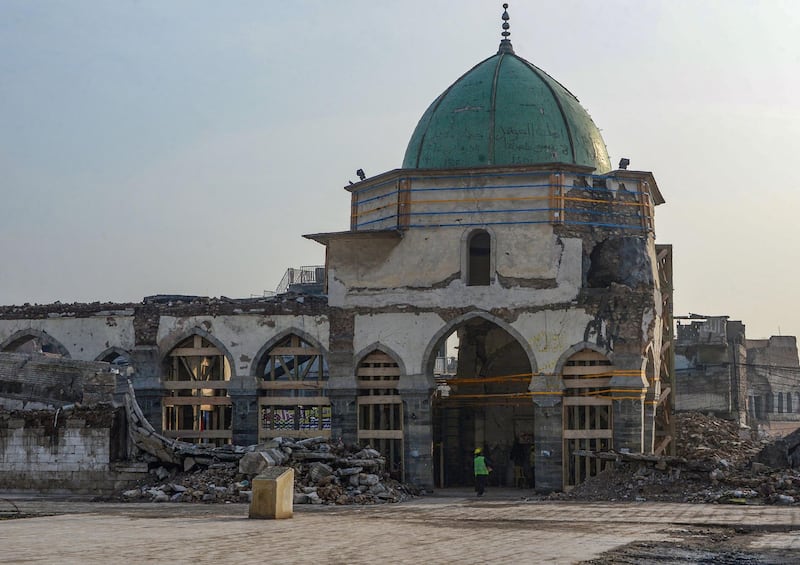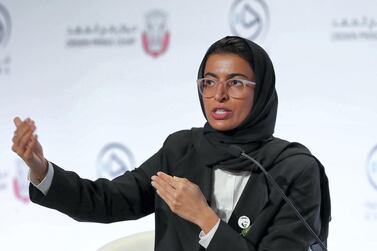Three years after ISIS blew up the famous leaning minaret of Mosul's historic Al Nuri Mosque, the first phase of a collective rebuilding has finished, Noura Al Kaabi, the UAE's Minister of Culture and Knowledge Development, told The National.
The area is completely clear of landmines and rubble from the conflict, and a new structure and base for the mosque is complete, Ms Al Kaabi said.
In 2018, the UAE stepped in to fund the construction of the momentous building, working with the UN’s cultural agency and the Iraqi government to restore the famed mosque.
“His Highness Sheikh Mohamed bin Zayed looked at this project and he simply didn’t want to have that specific site to be remembered for the wrong reasons,” Ms Al Kaabi said.
“It was an easy decision to help rebuild something so important to our common humanity and historical thread between us and the Iraqis."
Nearly two years later, work on the rebuilding can now begin.
“Phase one of the project is now complete," Ms Al Kaabi said. "The removal of the rubble and securing the place was the most crucial thing to start with. This is what we’re excited about."
The 12th century mosque and its famous leaning minaret, nicknamed “the hunchback”, is synonymous with the city of Mosul.
It looked over the city for more than 800 years by the time ISIS took control in the summer of 2014.
The destruction of the mosque and the ruins of the old city are linked, so its reconstruction will help to raise morale and optimism for the people of Mosul, known as Mislawis, Ms Al Kaabi said.
Work began after a conference in 2018, called “Reviving the Spirit of Mosul”, led by the UN cultural agency Unesco.
Now the UAE, Unesco and the Iraqi government are working in partnership with local builders and tradesmen on the reconstruction.
The next stage will be to "define scenarios for the reconstruction with related development of design solutions", Maria Rita Acetoso, senior project manager at Unesco's Iraq office, told The National.
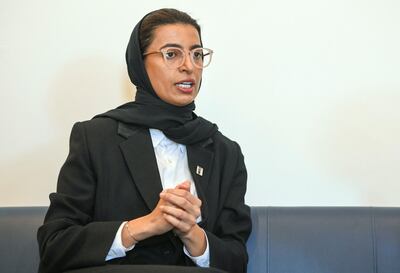
"This will be done through a consultative process that will engage local community and stakeholders at the maximum extent, to start the actual reconstruction once the design phase will be completed."
As part of $50.4 million (Dh185m) provided by the UAE, the project will employ 1,000 people, helping to revive a city where jobs, houses and services are in short supply.
A hundred Iraqis are already on site, including 10 archaeologists. That number will rise as work begins on two other projects, the Al Tahera and Al Saa’a churches in the city.
The UAE’s cultural ministry, Unesco and Sharjah’s International Centre for the Study of the Preservation and Restoration of Cultural Property are launching a training project to help with the rebuilding.
It will offer “training on how to help with the recovery, understanding and how to restore and to make sure there is this education of the tangible and intangible heritage", Ms Al Kaabi said.
Employment opportunities for qualified professionals and skilled craftsmen will be made within the continuing works to rebuild Mosul’s monumental landmarks.
Heritage conservation is at the top of the programme’s agenda, as well as preparing Mislawi professionals to actively contribute.
There is a special focus on the process of recovery, Ms Al Kaabi said.
It will not only concentrate on the physical rebuilding, but also social, economic and environmental recovery, she said.
In July 2014, ISIS leader Abu Bakr Al Baghdadi delivered a Friday sermon from Al Nuri Mosque's pulpit, presenting himself as the head of the terror group that overran large areas across Syria and Iraq.
The extremists rigged the mosque and its 850-year-old tower with explosives and blew them up as one of their last destructive acts before the city was liberated.
For Ms Kaabi, the project is not just about the rebuilding. It is also about bringing life back to the city that was once known to harbour the world's most feared terror organisation.
During the battle to retake the city from the insurgents, much of Mosul’s landmarks were turned to rubble by urban warfare between ISIS and the US-backed international coalition.
“What I like is that there are many findings of the minaret, especially of its tones, which is considered to be of help with the restoration of the mosque and the leaning minaret,” Ms Al Kaabi said.
A technical committee has been established to decide how the mosque and the leaning minaret will look like after the restoration.
“There are many questions," Ms Al Kaabi said. "Are we extending the shade for the prayers? Will it stay as it is? Will the leaning minaret remain leaning?
"There is an emotional attachment that it should look as it did before. I just know that the Sunni Endowment, the ministry of culture in Iraq, are very much determined to have it fully restored."
Phase two of the project will continue with the rebuilding but concentrate on the small details.
The mosque was built by and named after Nuruddin Al Zanki, a famed commander and a modern-day Saladin, whose family ruled the provinces of Aleppo and Mosul on behalf of the Abbasid caliph in Baghdad.
It was built in 1172-73, shortly before his death, and housed an Islamic school.
During the next 200 years, its minaret began to lean.
The mosque was one of the most famed monuments in Islam after the grand mosques of Mecca and Medina, Al Aqsa in Jerusalem and the Umayyad mosque in Damascus.
The UAE will also support reconstruction of the 800-year-old Al Tahera and Al Saa'a churches.
The city’s public library and university were also left in disrepair a year after the city was recaptured from the insurgents.
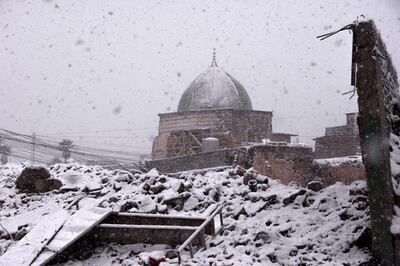
The central public library, a research centre that housed rare manuscripts including government records dating back to the Ottoman era, was the only one to survive ISIS intact, even though it was used as a base.
But with optimism running high across the city, students have been taking part in helping to restore their heritage, Ms Al Kaabi said.
“There are certain activities that are occurring in Mosul, from music to book fairs," she said.
"The students of the University of Mosul are trying their best also to get books and equipment to help rebuild and restore the university."
The culture of building, she said, would give Mislawis and Iraqis a sense of belonging.
“That sight by itself will psychologically help people on how to perceive the future of their city,” Ms Al Kaabi said.
